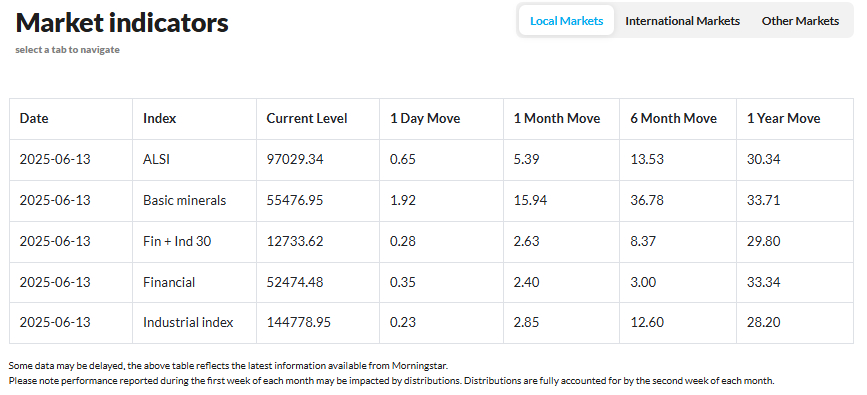Oil prices rise further on trade war relief
In South Africa, the rand weakened on Thursday following the release of disappointing domestic mining output figures. By 15h44 GMT, the rand was trading at 17.7850 against the US dollar, down around 0.20% from Wednesday’s close. The currency, often influenced by global risk sentiment and US economic indicators, had earlier fallen by nearly 1% in response to the subdued US producer price data, which raised expectations that the Federal Reserve may accelerate its monetary easing cycle. On the domestic front, mining production contracted by 7.70% year-on-year in April, marking the sixth consecutive monthly decline, according to Statistics South Africa. Despite the weak data, the Johannesburg Stock Exchange’s Top 40 index (JTOPI) closed 0.80% higher.
On Wall Street, the S&P 500 and Nasdaq both edged up by 0.20%, while the Dow Jones Industrial Average slipped by approximately 40 points. The modest gains followed the release of softer-than-anticipated US producer price data, which eased concerns that recent tariff measures were fuelling inflation. The figures suggested that inflationary pressures linked to trade policies have yet to take hold. However, investor sentiment was dampened by renewed uncertainty surrounding global trade. President Donald Trump announced plans to send formal letters within the next one to two weeks to key trading partners, outlining unilateral tariff measures aimed at pushing for new trade agreements. Meanwhile, initial jobless claims in the US came in slightly above expectations, adding to the cautious tone.
In the United Kingdom, the FTSE 100 rose by 0.20% to reach a new record high of 8,880 on Thursday, outperforming most European peers. The rally came as weaker-than-expected UK economic data bolstered hopes of an imminent interest rate cut by the Bank of England. GDP contracted by 0.30% in April—more than forecast—raising fresh concerns about the UK’s economic momentum. Additionally, exports to the United States recorded a sharp decline, largely due to earlier tariff measures. The soft economic indicators fuelled speculation that the Bank of England may move to ease policy sooner than previously anticipated.
Across continental Europe, equities retreated amid growing trade tensions. The STOXX 50 index declined by 1.30%, while the broader STOXX 600 shed 0.30%. Market jitters were reignited by President Trump’s announcement regarding the upcoming tariff letters, which added a layer of uncertainty to global trade relations and weighed on investor confidence.
In Asia, Japanese equities snapped a four-day winning streak. The Nikkei 225 Index fell by 0.65% to close at 38,173, while the broader Topix Index declined by 0.21% to 2,783. The downturn followed President Trump’s renewed threat to impose unilateral tariffs within a fortnight in an effort to secure new trade deals, though a similar pledge made on 16 May had not been enacted. The uncertainty cast a shadow over market sentiment.
In China, mainland stock markets showed limited movement amid persistent unease over US-China trade relations. The Shanghai Composite inched up by 0.01% to close at 3,403, while the Shenzhen Component slipped by 0.11% to 10,234, reflecting the market’s struggle to find clear direction.
In commodities, WTI crude oil futures declined to around $67.50 per barrel on Thursday, retreating from a two-month high reached in the previous session. The drop followed renewed concerns over potential supply disruptions due to escalating tensions between the United States and Iran. Meanwhile, gold prices continued to climb, nearing $3,390 per ounce and reaching their highest level since early May, as investors sought safe-haven assets in response to softer US economic data and heightened geopolitical risks.
Read full report.
